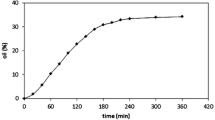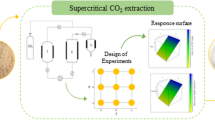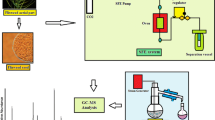Abstract
Utilization of renewable resources and development of new processes aimed at converting these materials into value added bio-products are gaining more emphasis. The scope of this study was to optimize supercritical CO2 extraction (SFE) parameters such as pressure, temperature and flow rate for the yields of unsaturated fatty acids from Pistacia terebinthus berries by a Box-Behnken statistical design. All samples were analyzed for fatty acids by GC-FID. The most effective variables were pressure (P < 0.005) and flow rate (P ≤ 0.005). Maximizing the evaluative criteria for dependent variables (oleic acid, linoleic acid and linolenic acid), optimal conditions were determined to be 240 bar, 60 °C and a flow rate of 16 g/min yielding 51.2% oleic acid, 26.5% linoleic acid and 1.0% linolenic acid. The amounts of unsaturated fatty acids in SFE samples (81.3%) were higher than the hexane (74.3%) and were similar to that of cold press samples (80.1%). High concentrations of unsaturated fatty acids can indicate the utilization of the berries as a major dietary source and demonstrate challenges for industrial application of SFE as a green technology.




Similar content being viewed by others
References
Baytop T (1984) Therapy with medicinal plants in Turkey. Istanbul University Publications Pub. No: 3255, Faculty of Pharmacy Pub. No: 40, Istanbul p. 520
Mizi A, Djedaia S (2010) Physico-chemical and biochemical properties of oil extracted from Pistacia lentiscus. Asian J Chem 22:646–650
Charef M, Yousfi M, Saidi M, Stocker P (2008) Determination of the fatty acid composition of acorn (Quercus), Pistacia lentiscus seeds growing in Algeria. JAOCS 85:921–924
Benhassaini B, Bendahmane M, Benchalgo N (2007) The chemical composition of fruits of Pistacia atlantica desf. subsp. atlantica from Algeria. Chem Nat Comp 43:121–124
Kizil S, Turk M (2010) Microelement contents and fatty acid compositions of Rhus coriaria L. and Pistacia terebinthus L. fruits spread commonly in the south eastern Anatolia region of Turkey. Nat Prod Res 24:92–98
Gecgel U, Arici M (2009) Studies on physic-chemical properties. Fatty acid composition of Terebinth (Pistacia terebinthus L.) oil and presence of aflatoxins in fruits. Asian J Chem 21:1559–1564
Matthaus B, Ozcan MM (2006) Quantitation of fatty acids, sterols, and tocopherols in turpentine (Pistacia terebinthus Chia) growing wild in Turkey. J Agric Food Chem 54:7667–7671
Bakirel T, Sener S, Bakirel U, Keles O, Sennazli G, Gurel A (2003) The investigation of the effects of P. terebinthus L. upon experimentally induced hypercholesterolemia and atherosclerosis in rabbits. Turkish J Vet Sci 27:1283–1292
Topcu G, Ay M, Bilici A, Sarikurkcu C, Ozturk M, Ulubelen A (2007) A new flavone from antioxidant extracts of Pistacia terebinthus. Food Chem 103:816–822
Demirbuker-Kavak D, Altiok E, Bayraktar O, Ulku S (2010) Pistacia terebinthus extract: As a potential antioxidant, antimicrobial and possible β-glucuronidase inhibitor. J Molecular Catalysis B: Enzymatic 64:167–171
Duru ME, Cakir A, Kordali S, Zengin H, Harmandar M, Izumi S, Hirat T (2003) Chemical composition and antifungal properties of essential oils of three Pistacia species. Fitoterapia 74:170–176
Oilseeds—determination of oil content (reference method) (1998) International Standards ISO 659: 1998, ISO: Geneva
Wang L, Yang B, Du X, Yi C (2008) Optimisation of supercritical fluid extraction of flavonoids from Pueraria lobata. Food Chem 108:737–741
Oliveira R, Rodrigues MF, Bernardo-Gil MG (2002) Characterization and supercritical carbon dioxide extraction of walnut oil. JAOCS 79:225–230
Bozan B, Temelli F (2002) Supercritical carbon dioxide extraction of flaxseed. JAOCS 79:231–235
Beis SH, Dunford NT (2006) Supercritical fluid extraction of daphne (Laurus nobilis L.) seed oil. JAOCS 83:953–957
Fasina OO, Craig-Schmidt M, Colley Z, Hallman H (2008) Predicting melting characteristics of vegetable oils from fatty acid composition. LWT–Food Science Tech 41:1501–1505
Fernandez L, Diaz de Apodaca E, Cebrian M, Villaran MC, Mate JI (2007) Effect of the unsaturation degree and concentration of fatty acids on the properties of WPI-based edible films. Eur Food Res Technol 224:415–420
Acknowledgments
We thank to the Center for Drug R&D and Pharmacokinetic Applications (ARGEFAR) of Ege University for access to their facilities.
Author information
Authors and Affiliations
Corresponding author
About this article
Cite this article
Senyay-Oncel, D., Ertas, H. & Yesil-Celiktas, O. Effects of Supercritical Fluid Extraction Parameters on Unsaturated Fatty Acid Yields of Pistacia terebinthus Berries. J Am Oil Chem Soc 88, 1061–1069 (2011). https://doi.org/10.1007/s11746-010-1753-0
Received:
Revised:
Accepted:
Published:
Issue Date:
DOI: https://doi.org/10.1007/s11746-010-1753-0




